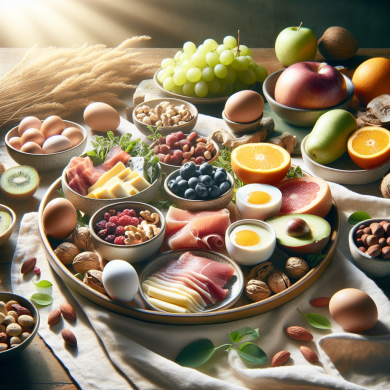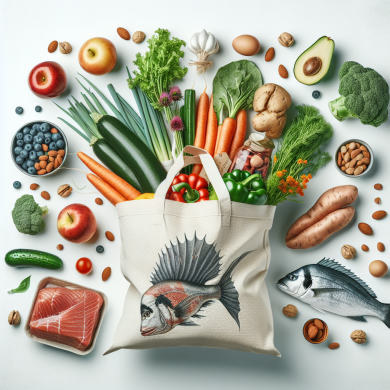Essential Paleo Diet Food List for Beginners
Introduction to the Paleo Diet
The Paleo diet, also known as the Paleolithic or “caveman” diet, is a nutritional plan that seeks to emulate the dietary habits of our ancient ancestors. The core principle of the Paleo diet is to consume whole, unprocessed foods that were available to humans before the advent of agriculture. This dietary approach focuses on high-quality protein, healthy fats, and fresh produce while eliminating processed foods, grains, legumes, and dairy. Proponents of the Paleo diet argue that it can lead to improved health, weight loss, and reduced risk of chronic diseases.
Benefits of the Paleo Diet
Before diving into the essential food list, it’s important to understand why many people choose to follow the Paleo diet. Some of the potential benefits include:
- Weight Loss: By eliminating processed foods and focusing on whole, nutrient-dense options, individuals may experience weight loss and improved body composition.
- Improved Digestion: Removing grains and legumes can alleviate digestive issues for some people, leading to better overall gut health.
- Increased Energy Levels: The emphasis on protein and healthy fats can provide a steady source of energy throughout the day.
- Reduced Inflammation: The Paleo diet often includes foods rich in anti-inflammatory properties, which may help reduce inflammation in the body.
- Better Blood Sugar Control: By cutting out refined sugars and carbohydrates, the diet can help stabilize blood sugar levels.
Essential Paleo Diet Food List for Beginners
As a beginner, it can be challenging to know which foods to include in your Paleo diet. Below is a comprehensive list of essential foods that align with Paleo principles:
Protein Sources
- Grass-Fed Meat: Opt for beef, lamb, and other meats that come from grass-fed animals. These options are typically higher in omega-3 fatty acids and lower in omega-6 fatty acids, which can help reduce inflammation.
- Free-Range Poultry: Chicken, turkey, and eggs from free-range sources are preferable, as they tend to be more nutrient-dense and ethically produced.
- Wild-Caught Fish and Seafood: Salmon, mackerel, sardines, and other fatty fish are excellent sources of omega-3 fatty acids and protein. Shellfish like shrimp and crab are also great additions.
- Game Meat: Bison, elk, and venison are lean and nutritious options that align with the Paleo philosophy.
Fruits and Vegetables
- Leafy Greens: Kale, spinach, Swiss chard, and other leafy greens are packed with vitamins, minerals, and antioxidants.
- Cruciferous Vegetables: Broccoli, cauliflower, Brussels sprouts, and cabbage are nutrient-dense and support detoxification.
- Root Vegetables: Sweet potatoes, carrots, and beets are excellent carbohydrate sources and provide essential nutrients.
- Fruits: Berries, apples, oranges, and bananas are Paleo-friendly fruits that offer natural sweetness and important vitamins.
- Squash and Zucchini: These versatile vegetables can be used in a variety of dishes and provide important nutrients and fiber.
Healthy Fats
- Avocado: A rich source of monounsaturated fats, avocados are versatile and can be used in salads, smoothies, or as a topping.
- Nuts and Seeds: Almonds, walnuts, flaxseeds, and chia seeds are great for snacking and provide essential fatty acids.
- Olive Oil: Extra virgin olive oil is a staple in the Paleo diet due to its heart-healthy monounsaturated fat content.
- Coconut Oil: Rich in medium-chain triglycerides, coconut oil is excellent for cooking and adds flavor to many dishes.
Herbs and Spices
- Garlic and Onions: These flavorful ingredients are staples in many Paleo recipes and offer numerous health benefits.
- Herbs: Basil, oregano, rosemary, thyme, and cilantro are great for adding flavor without calories or additives.
- Spices: Turmeric, cinnamon, ginger, and paprika not only enhance the taste of your meals but also offer anti-inflammatory properties.
Beverages
- Water: Staying hydrated is crucial, and water should be your primary beverage choice.
- Herbal Teas: Caffeine-free herbal teas like chamomile or peppermint are excellent alternatives to sugary drinks.
- Coconut Water: A natural source of electrolytes, coconut water can be a refreshing option post-workout.
Foods to Avoid on the Paleo Diet
To fully embrace the Paleo lifestyle, it’s essential to avoid certain food groups that were not part of our ancestors’ diets:
- Grains: Wheat, rice, oats, and other grains are typically excluded due to their high carbohydrate content and potential to cause digestive issues.
- Legumes: Beans, lentils, and peanuts are not considered Paleo-friendly because they contain compounds that may interfere with nutrient absorption.
- Dairy: Milk, cheese, and yogurt are generally avoided, although some people choose to incorporate fermented dairy products or those from grass-fed sources.
- Refined Sugars: Table sugar, high-fructose corn syrup, and other sweeteners are eliminated in favor of natural alternatives like honey and maple syrup.
- Processed Foods: Foods with artificial additives, preservatives, and unhealthy fats are avoided to maintain a clean and natural diet.
Tips for Transitioning to a Paleo Diet
Starting a new diet can be challenging, but with the right approach, you can make the transition to a Paleo lifestyle smoother:
- Plan Your Meals: Take time to plan your meals and snacks for the week, ensuring you have Paleo-friendly options readily available.
- Start Slowly: If you’re new to the Paleo diet, consider gradually eliminating non-Paleo foods and introducing Paleo options one at a time.
- Experiment with Recipes: Explore new recipes and cooking techniques to keep your meals exciting and varied.
- Listen to Your Body: Pay attention to how your body responds to the diet and make adjustments as needed.
- Stay Informed: Continuously educate yourself about the Paleo diet to stay motivated and informed about its benefits.
Conclusion
The Paleo diet offers a holistic approach to eating that prioritizes whole, unprocessed foods and aligns with the dietary habits of our ancestors. By focusing on high-quality protein, healthy fats, and fresh produce, individuals can experience numerous health benefits, including weight loss, improved digestion, and increased energy levels. Whether you’re considering the Paleo diet for its potential health benefits or simply looking for a cleaner way of eating, this essential food list for beginners provides a solid foundation to start your journey. Remember, the key to success with the Paleo diet is to embrace whole foods, listen to your body, and enjoy the process of discovering new, nourishing foods.















Add comment